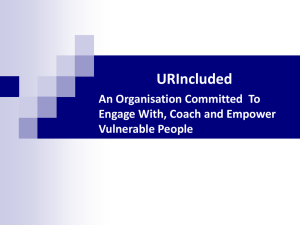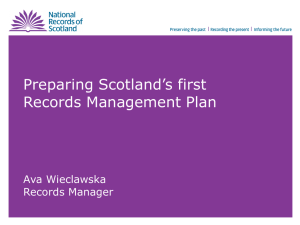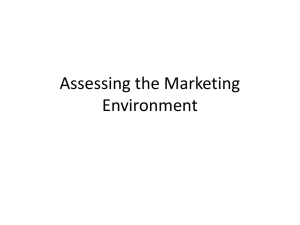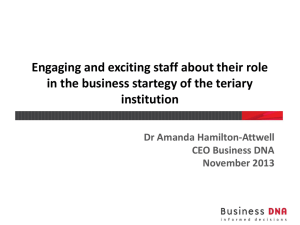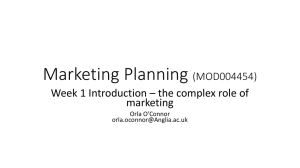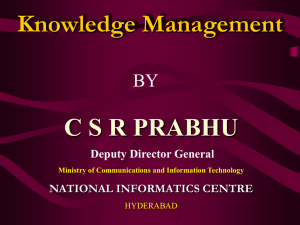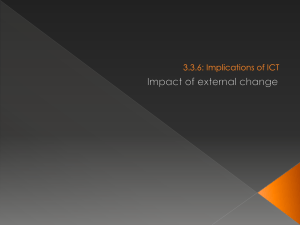Project V Line Management
advertisement
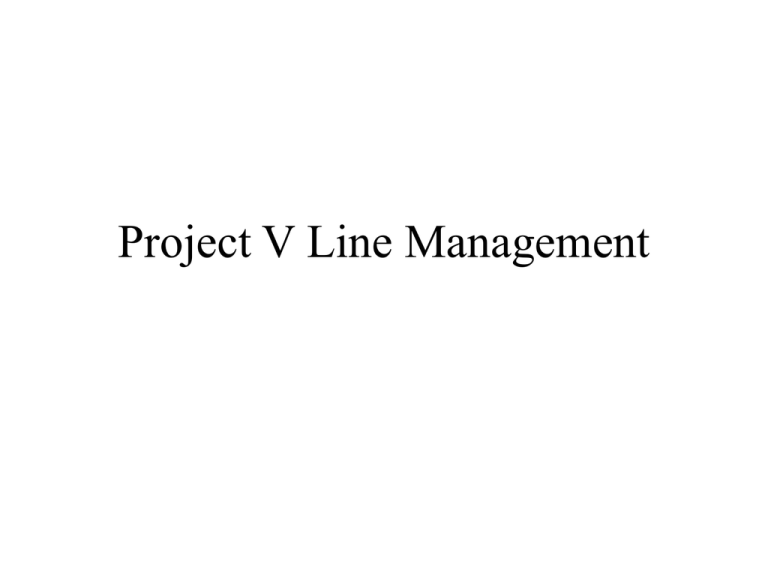
Project V Line Management Definition of Project Management – A project can be defined as a ‘nonrepetitive activity’. This needs augmenting by other characteristics: • it is goal oriented - it is being pursued with a particular end or goal in mind; it has a particular set of constraints - usually centred around time and resource; the output of the project is measurable; something has been changed through the project being carried out. – Project management includes planning, organising, directing and controlling activities in addition to motivating what are usually the most expensive resource on the project - the people. – Planning involves deciding what has to be done, when and by whom. – The resources then need to be organised through activities such as procurement and recruitment. – Directing their activities towards a coherent objective is a major management role. – The activities also need controlling to ensure that they fit within the limits (e.g. financial) set for them. The project as a conversion process Constraints: financial legal ethical environmental logic activation time quality indirect effects Output: Input: satisfied need want/need Project Mechanisms: people knowledge and expertise capital tools and techniques technology Complexity of Projects • The level of complexity is a function of: the number of people, departments, organisations and nations involved (the organisational complexity) the volume of resources involved, time, capital, processes (the resource complexity or scale) the level of innovation involved in the product or the project process (the technical complexity) Scale • The scale of projects can be further described using the following typology: is the project – strategic, – systems-based, or – operational? Strategic • • • • Timescale Degree of change to customers Likely complexity Effects of project 2 - 5 years high high impact felt throughout organisation and beyond • Change to customers/users of output change what is done Systems • • • • Timescale Degree of change to customers Likely complexity Effects of project 1 - 2 years medium medium impact limited to most parts of the organisation • Change to customers/users of output change to the way that things are done Operational • • • • Timescale Degree of change to customers Likely complexity Effects of project up to 1 year low low impact limited to the function within which project undertaken • Change to customers/users of output change who, where, when and means of doing something e.g. Manufacturing • (lighting fittings manufacturer) • develop new products • implement quality system • change operating procedures on the shop-floor e.g. Service • (general hospital) • add or remove facility (A&E department) • contract out cleaning services • find new supplier for surgical supplies e.g. Construction • (housing developer) • develop designs for a series of standard houses • use contractors rather than employees to manage projects • cross-train decorators and plumbers Project Management and Line Management • At the head of each of the major functions within an organisation there will be functional or line managers. These managers have the responsibility for the people who work under them in their departments. • The project manager may have a line management role as well, but is responsible for projects that may run across several functions. Line / functional managers Project Manager marketing quality finance operations personnel purchasing Line management • • • • • • • • • responsible for managing the status quo authority defined by management structure consistent set of tasks responsibility limited to their own function works in ‘permanent’ organisational structures tasks described as “maintenance’ main task is optimisation success determined by achievement of interim targets limited set of variables Project management • • • • • • • • • responsible for overseeing change lines of authority ‘fuzzy’ ever-changing set of tasks responsibility for cross-functional activities operates within structures which exist for the life of the project predominantly concerned with innovation main task is the resolution of conflict success determined by achievement of stated end-goals contains intrinsic uncertainties • The split between tasks that can be considered as maintenance (maintaining the status quo) and innovation is changing. • On the figure, the trend is for the line AB to move downwards - increasing the degree of innovation activities required from line managers. • The result of this is a change in the role of line managers and a reduction in the difference in the roles of line and project managers. Innovation A Project Management Line Management B Maintenance The Traditional Organisation The line or functional organisation represents stability for employees. A standard organisation has an existing vertical communications system already in place. In a department there are existing budgeting and cost accounting controls in place. There is better technical control in line organisations. Line organisations are set up to handle routine and recurring tasks. Failure Of Line Organisations In Projects • Lack of Focus and Attention • Inability to Cope with Different Project Characteristics • Feelings of Being Used and Exploited • Lack of Project Experience So If a Separate Project Idea Is So Good, Why Not? • So, the idea of separating project structures from the normal organisation is a good one. • But, a company cannot operate for a prolonged period of time on projects alone. • You need an infrastructure within the organisation to succeed in the long term. – How to get benefits from both worlds-completing the projects done while keeping the organisation intact. Enter the matrix organisation. Advantages • Very good for project-oriented companies • Ensures that people on projects are utilised (as otherwise they are returned to the pool) • Project manager tends to be powerful in getting resources • Accountability and tracking of projects improved • Possibility that people who move between projects can build skills • Provides formal structure for projects of medium to large size • Ability to track what people are working on in projects Disadvantages • Good people will be in heavy demand for projects; others, who are not so good, will sit in the unassigned pool. • Difficult to assign control between project and tine management • Line managers tend to be weak. • Projects with long lives tend to be confused with line organisations. • Difficult to share resources between projects • More difficult to have lessons and skills cross projects - less chance for organisation history • Project prospers and traditional organisation suffers • More difficult to anticipate resource needs and to staff for requirements • More difficult to address small projects Project Management will involve financial management - through the preparation of a financial case to meet the needs set out in the project brief; personnel management - the identification of skills required, the selection of staff, their motivation and welfare; operations management - there are often parts of a project that are repetitive in nature and so can be treated as individual operations; purchasing and logistics - the identification of material and service needs, suppliers, their selection and the management of the logistics (location and transport of materials); technical specialisms - e.g. new product development, engineering, programming, quality management; marketing - projects generated for both internal and external customers will need to have explicit statements of needs drawn up and then be ‘sold’ to the customer. The Use of Project Management Consultants An integrator An honesty-broker A change-agent A knowledge provider A resource provider A checker A trainer Employing Consultants • The first stage in employing consultants is to decide exactly what it is that they are being brought in to achieve. The evaluation of the suitability of one or other firm can be done through: – – – – membership of appropriate professional bodies; talking to previous clients; closely evaluating their capabilities; evaluating the costs for the job, in particular whether there is any financial incentive for them to finish the job in a given time, and whether their fee is linked to tangible benefits achieved from their work.


